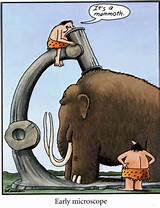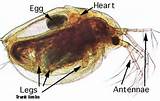(Part 2 of the trilogy, August 3rd)

Early microscope: ‘It’s a mammoth!’ (By Gary Larson)
After the little historic excursion two weeks ago we’ve now arrived at today’s world of science. Even for those among you who are aware of the theories about non-material reality, one big challenge remains: how do you PROVE to a critical public that non-material processes exist?
Modern scientific experiments are based on experimental set-ups that are often very specialized and designed to prove a particular hypothesis, a statement if you like. For example, imagine you want to investigate the number and type of life forms living in the soil of a particular area. As a scientist, you would usually go to that area, equipped with a so-called sample grid (you need to take samples at more than one place in order to make your study sound), some pots to put your soil samples in, and maybe some preservative (in order to prevent the animals from rotting or reproducing before you are able to look at them). Analyzing these samples would give you a fair idea of what has been living in the soil of this particular area at the time you were taking your samples there.
Where today’s scientific methods fall short
Now imagine that you analyze your samples with your bare eye. You might find some species of worms, some bugs and maybe some other critters you have never seen before. These are your results. But are they correct?
Yes.
Yes, they are correct for the method you applied. With the bare eye, you could not have found more species in your samples. Now imagine that you had a magnifying glass. And you analyze your samples in the same way: look at them and determine what you see.
Ah! You might see that in fact two of the worms that look very similar differ in the a small way. Maybe their mouths are built slightly different. Or the number of body segments differs.
Do you see? Your findings are affected a great deal by the equipment you are using. Does that illustrate the major importance of technology in today’s scientific experiments clear enough?
More advanced technology allows more detailed results. And maybe even new discoveries.
What implications does this knowledge have on my little experiment of proving how holistic medicine might work?
I invite you might give this a few thoughts of your own before you read on.
Expand your vision
We’ve established that the amount of detail we see is depending on the kind of magnification we have to our disposal. A person with sharp eyes sees more detail than a person who needs prescription glasses. Everyone sees more detail through a magnifying glass than with their bare eye. Now imagine what might have happen if you had a microscope that allowed you to see even more; a microscope that would have allowed you to see life forms as small as one cell. With that microscope you even might have found some bacteria hidden among the soil grains! And would this have changed your result as to how many life forms there are in that particular area? It most likely would have.
What is true for soil samples also holds for water samples. During my PhD work I worked with waterfleas (Daphnia), that are barely visible to the naked eye. Waterfleas are (freshwater) aquatic arthropods like crabs, lobsters and shrimps. They are crucial in keeping the water clear and thus help preventing algal blooms (like the toxic blue algae that may prevent you from swimming in your favorite lake during summer). Waterfleas are small, measuring roughly 0.5-5 mm and to distinguish different species is rather impossible without magnification. Let’s see what waterfleas look like with the help of modern technology:

Photograph of a waterflea taken with a common dissecting microscope (2)

Scanning electron microscopy photograph of a young waterflea, probably ca. 1 mm long (3)
These two pictures illustrate a wonderful dilemma of science today: On the left picture you see a microscope picture with much less detail than on the right picture which was taken with an electron microscope. So on one hand, modern technology allows us to find out much more than we knew before. On the other hand, this where the trouble starts: your result is determined to a great deal by the techniques you have at your disposal to analyze your samples. You will discover more by using a magnifying glass than by only using your bare eye. And you will learn even more by using a microscope that by using a magnifying glass. It sounds logical to me. Now please imagine that you don’t have a microscope at your disposal; you have to suffice with a magnifying glass. Being a scientist, of course you know that your results show a limited version of the true number of life forms in your samples. You know that a microscope would have given you a different, more detailed result.
Wanted: Curious genius
This phenomenon holds for the whole field of science: if science choses to ignore phenomena that are not yet ‘scientifically proven’, how will scientists ever invent a technology that is actually able to prove that there is more than they have discovered so far? It would need a curious genius with an inventive mind to design a machine to prove the phenomena he considers might exist ( f.ex. holistic medicine phenomena), to take the next step. To design, if we take the soil sample example, the microscope to expand the results gained using the magnifying glasses.
This is the dilemma of science and always has been: Science is only as accurate as the equipment it has at its disposal.
 Therefore, the experiment of our curious genius trying to prove his wild advanced theories is bound to fail if he uses only the equipment that he has at his disposal today. He will fail to ever arrive at a positive answer confirming his new theory.
Therefore, the experiment of our curious genius trying to prove his wild advanced theories is bound to fail if he uses only the equipment that he has at his disposal today. He will fail to ever arrive at a positive answer confirming his new theory.
For the simple reason that you simply won’t see bacteria with the bare eye.
Our genius could be satisfied with this, having tried to prove his idea in a scientifically sound manner. Or he might wonder about what else he could try to prove his ‘gut feeling’ valid. Eventually he might come up with a machine advanced and novel enough to prove his ‘gut feeling’ right. But this may take time. And until this futuristic new-invention-to-come yields first results that are reliable, even more time will pass. Therefore: how long will it take our genius to get any of those results unscathed thought the established scientific maze of criticism into the public media.
I can only guess…
What do you recon?
I am curious where this road may take us. So far, we’ve gained wonderful insights since the dawn of science as we know it today. Many of them who have been outdated again already by even more complex and complete theories.
What’s next?
If you liked this article, mark the following data in your agenda:
‘Holistic medicine – Where today’s scientific methods fall short’ (Part 2 of the trilogy) (August 3rd)
‘Holistic medicine – Science dilemma and way forward’ (Part 3 of the trilogy)(August 17th)
’10 practical and fun tips for living with (high) sensitive children’ (August 31th)
My number 1 desire is to inform and inspire you. Sign up for my blog and you will be provided automatically with more insightful information and inspiring mind-travels.
Image credits 1, 2, 3